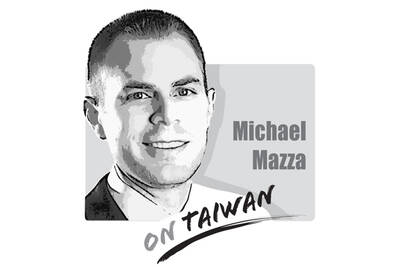A western philosopher once referred to “a blind man in a dark room looking for a black cat that is not there.” It is a comment on the metaphysical dilemma in which academics have exhausted big efforts on the dialectical wording for the non-existence of being.
On the contrary, Taiwan, as an existing political entity, has passed the progressive Greenhouse Gas Reduction and Management Act (溫室氣體減量及管理法), and outlined its Intended Nationally Determined Contributions (INDC) — publicly declared actions the nation intends to take under a new global climate change agreement. However, it still cannot officially participate in the UN Climate Change Conference in Paris with 195 other parties.
As for the ranking of carbon dioxide emitting nations, Taiwan was not originally shown on the world map. However, since the 1970s, the nation’s economic transition, industrialization, rise in exports and GDP growth have made Taiwan one of the four Asian Tigers and one of the world’s major industrial factories.
As a result, Taiwan has imported more coal and oil, and carbon dioxide emissions have increased annually by 6 to 8 percent. With the increased pollution, the sky over Taiwan has also grown dusky. Although small, Taiwan is a major emitter in the eyes of the International Energy Agency (IEA). However, in the eyes of the world, the nation is always seen by choice, or not seen at all.
The situation has changed since 2008. Taiwan’s overall emissions have more or less leveled off over the past seven years despite an increase in GDP. The intensity of Taiwan’s carbon dioxide emissions has fallen from 0.023kg per New Taiwan (NT) dollar in 2002 to 0.017kg per NT dollar in 2013 — a decrease of about 25 percent over the past 12 years — mainly as a result of an improvement in energy efficiency, industrial transformation and energy conservation, and carbon emissions reduction efforts. This transition pathway could be a remarkable demonstration for many developing countries.
If Taiwan were a member of the UN Climate Change Conference, it would appeal some points at the meetings:
‧ First, pay attention to the effects of global warming and sea-level rise on island countries in the Pacific, Indian and Caribbean oceans.
‧ Second, treat “historical responsibility” and “future responsibility” of greenhouse gas emissions equally.
‧ Third, establish a fair, third-party verification platform to audit countries’ greenhouse gas emissions, use it to support domestic allocation of emission allowances and establish a credible basis for a carbon market;
‧ Fourth, improve functions of international collaboration platforms on technology, finance, and law, in order to complete a transition from a “carbon economy” to a “green economy.”
Since 1992, the UN Framework Convention on Climate Change (UNFCCC) has embodied the “common, but differentiated responsibilities” as the UN’s emissions mitigation commitment.
However, this concept has not resulted in a satisfied realization. Greenhouse gas emissions are still running out of control.
It is our proposal that in the upcoming “Paris Agreement,” an “inclusive” component needs be added to the “common, but differentiated responsibilities;” rephrasing the concept as “common, but differentiated, and inclusive responsibilities.”
The UN should include, with the utmost generosity, all political entities that are willing and/or capable of contributing to carbon emissions reduction under the UNFCCC. In turn, our nation, people and cities would be treated more equally in dedicating their effort and financial capacity for human sustainability.
Wei Kuo-yen is the Environmental Protection Administration minister.
The image was oddly quiet. No speeches, no flags, no dramatic announcements — just a Chinese cargo ship cutting through arctic ice and arriving in Britain in October. The Istanbul Bridge completed a journey that once existed only in theory, shaving weeks off traditional shipping routes. On paper, it was a story about efficiency. In strategic terms, it was about timing. Much like politics, arriving early matters. Especially when the route, the rules and the traffic are still undefined. For years, global politics has trained us to watch the loud moments: warships in the Taiwan Strait, sanctions announced at news conferences, leaders trading
The saga of Sarah Dzafce, the disgraced former Miss Finland, is far more significant than a mere beauty pageant controversy. It serves as a potent and painful contemporary lesson in global cultural ethics and the absolute necessity of racial respect. Her public career was instantly pulverized not by a lapse in judgement, but by a deliberate act of racial hostility, the flames of which swiftly encircled the globe. The offensive action was simple, yet profoundly provocative: a 15-second video in which Dzafce performed the infamous “slanted eyes” gesture — a crude, historically loaded caricature of East Asian features used in Western

Is a new foreign partner for Taiwan emerging in the Middle East? Last week, Taiwanese media reported that Deputy Minister of Foreign Affairs Francois Wu (吳志中) secretly visited Israel, a country with whom Taiwan has long shared unofficial relations but which has approached those relations cautiously. In the wake of China’s implicit but clear support for Hamas and Iran in the wake of the October 2023 assault on Israel, Jerusalem’s calculus may be changing. Both small countries facing literal existential threats, Israel and Taiwan have much to gain from closer ties. In his recent op-ed for the Washington Post, President William
A stabbing attack inside and near two busy Taipei MRT stations on Friday evening shocked the nation and made headlines in many foreign and local news media, as such indiscriminate attacks are rare in Taiwan. Four people died, including the 27-year-old suspect, and 11 people sustained injuries. At Taipei Main Station, the suspect threw smoke grenades near two exits and fatally stabbed one person who tried to stop him. He later made his way to Eslite Spectrum Nanxi department store near Zhongshan MRT Station, where he threw more smoke grenades and fatally stabbed a person on a scooter by the roadside.